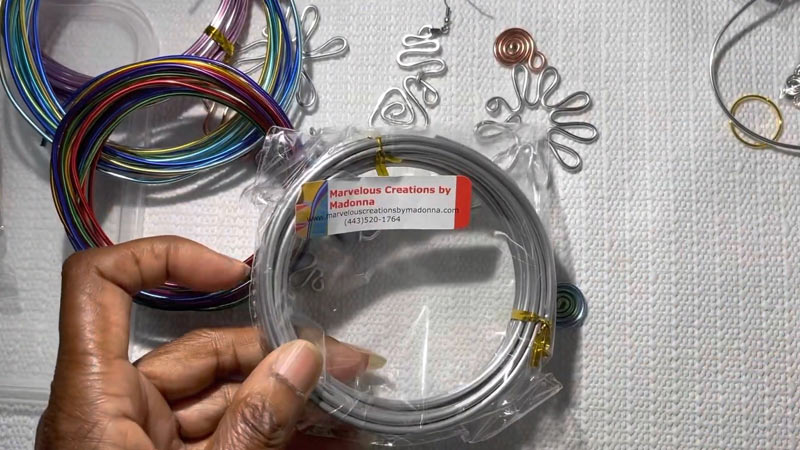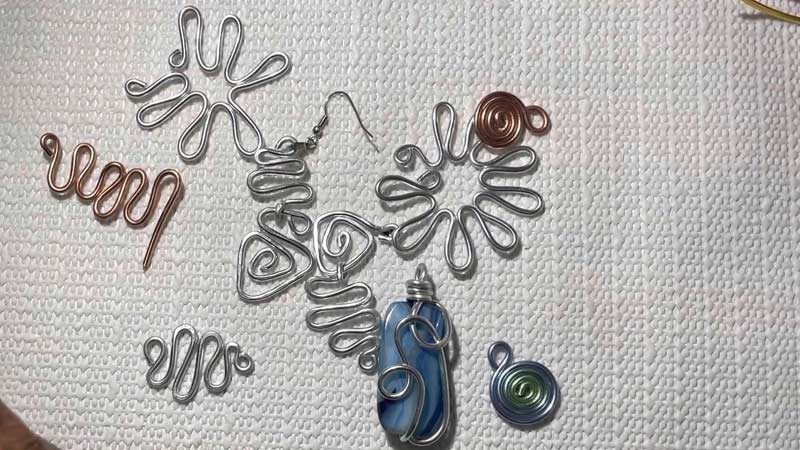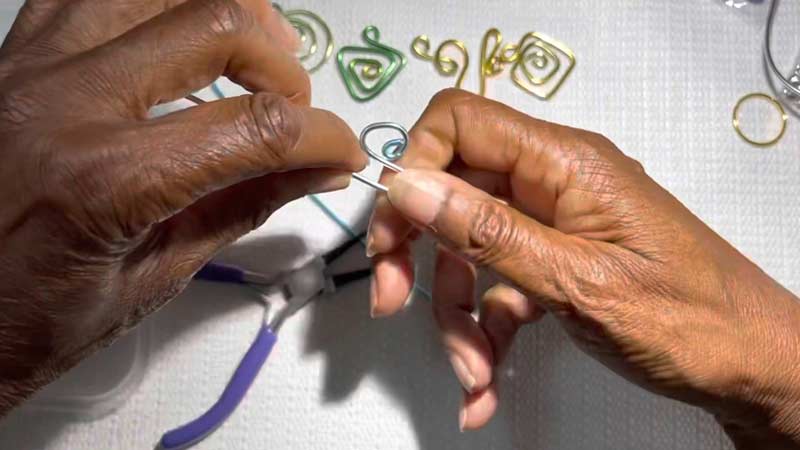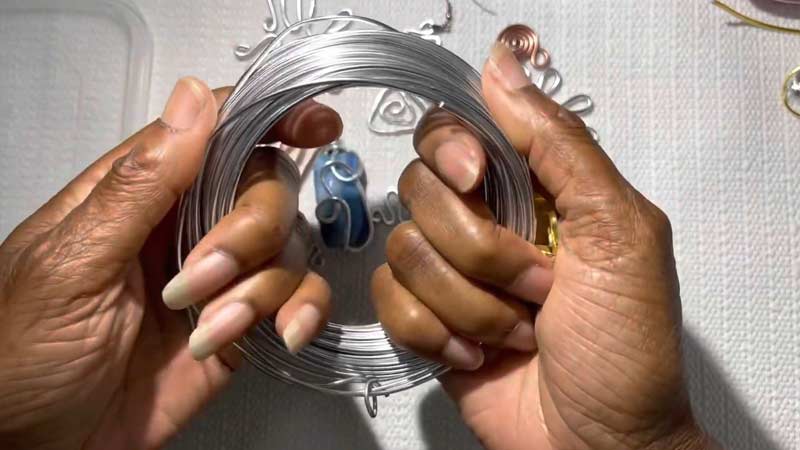Navigating the world of wire choices in jewelry making is crucial for crafting pieces that not only captivate aesthetically but also withstand the test of time. One often pondered question is, “Is aluminum craft wire good for wire-wrapped jewelry?”
To address this, it’s essential to delve into the properties and characteristics of aluminum craft wire, examining its malleability, durability, and overall suitability for the intricate art of wire wrapping.
In this exploration, we will weigh the pros and cons of using aluminum craft wire in wire-wrapped jewelry, considering factors that influence its effectiveness in bringing creative visions to life.

Is Aluminum Craft Wire Good For Wire Wrapped Jewelry?
Is aluminum wire good for jewelry making? Absolutely, and it’s a popular choice for wire-wrapped jewelry. Aluminum craft wire, known for its lightweight and malleable nature, is ideal for intricate designs and detailed wraps in jewelry.
The flexibility of aluminum wire allows for easy manipulation and shaping, making it well-suited for creating intricate patterns and delicate jewelry pieces.
Additionally, aluminum wire is available in a variety of vibrant colors, adding versatility and aesthetic appeal to your designs.
While it may not be as durable as some other metals, aluminum’s affordability, ease of use, and an array of color options make it an excellent choice for crafting beautiful and personalized wire-wrapped jewelry.
For those exploring craft wire for jewelry making, aluminum stands out for its creative potential and adaptability.
Does Aluminum Wire Tarnish?
Aluminum wire is known for its resistance to tarnish, making it an excellent choice for various crafting applications, including jewelry making.
Unlike some other metals, such as copper or sterling silver, aluminum does not undergo oxidation or tarnishing reactions when exposed to air.
This property is due to the protective oxide layer that naturally forms on the surface of aluminum, preventing corrosion and discoloration.
As a result, jewelry crafted from aluminum wire maintains its luster and appearance over time, requiring minimal maintenance.
This resistance to tarnish adds to the appeal of aluminum wire, particularly for those seeking durable and low-maintenance materials for their jewelry projects.
Best Wire For Jewelry Making
When it comes to wire wrapping jewelry or crafting intricate designs, choosing the right wire is crucial for achieving both aesthetic appeal and structural integrity. Here are seven types of wires widely used in jewelry making:
Aluminum Wire

Known for its lightweight and malleable nature, aluminum wire for jewelry is excellent for intricate designs. It comes in a variety of colors, is resistant to tarnish, and is perfect for creating lightweight and vibrant pieces.
Copper Wire
Copper wire is a popular choice for its durability, excellent electrical conductivity, and the warm, classic aesthetic it develops over time. It’s perfect for creating sturdy and timeless pieces that may develop a natural patina.
Sterling Silver Wire
Sterling silver wire combines elegance and durability. Ideal for creating high-quality jewelry, it is known for its brilliant shine and ability to retain intricate shapes.
Gold-Filled Wire
The gold-filled wire consists of a layer of gold bonded to a base metal. It offers the luxurious appearance of gold at a more affordable price, making it an excellent choice for elegant and durable jewelry.
Brass Wire
Brass wire is known for its warm, golden hue. It’s a cost-effective alternative to gold, providing a similar appearance. It’s durable and malleable, making it suitable for various jewelry designs.
Stainless Steel Wire
Stainless steel wire is prized for its strength, corrosion resistance, and affordability. It’s an excellent choice for creating durable and long-lasting jewelry with a modern and sleek aesthetic.
Niobium Wire
Niobium wire is hypoallergenic, making it an excellent option for those with metal sensitivities. It comes in a variety of colors through anodizing, adding a vibrant and unique touch to jewelry designs.
Choosing the best wire for your jewelry-making endeavors depends on the desired aesthetic, design complexity, and budget.
Each type of wire offers unique qualities that cater to different styles and preferences in the world of wire wrapping jewelry.
How To Harden Aluminum Wire?
Aluminum wire is a popular choice in jewelry making due to its malleability, but at times, it may be desirable to harden it for added durability or to hold specific shapes.
Here are five effective ways to harden aluminum wire:
Work Hardening by Hand

To increase the hardness of aluminum wire, you can manually work-harden it by bending and shaping it repeatedly. The more you manipulate the wire, the more rigid it becomes.
Use pliers or other shaping tools to create the desired form while enhancing its hardness.
Anodizing Process
Anodizing is a method that not only adds color to aluminum wire but also increases its surface hardness. The process involves immersing the wire in an electrolyte solution and passing an electric current through it, forming a protective oxide layer that enhances the wire’s hardness.
Tumble Polishing
Tumble polishing involves placing aluminum wire in a tumbler with abrasive media. As the tumbler rotates, the abrasives work on the wire’s surface, not only polishing it but also contributing to a harder finish. This method is suitable for pieces that can withstand slight surface changes.
Heat Treatment
By subjecting aluminum wire to controlled heat and then allowing it to cool, you can enhance its hardness.
This process is known as heat treatment or annealing. However, caution is necessary to avoid overheating, which could result in the wire becoming too brittle.
Hammering Technique
Hammering is an effective method to increase the hardness of the aluminum wire. Lay the wire on a sturdy surface and gently hammer it with a rubber or nylon mallet. The repeated strikes compact the metal, making it harder while retaining its shape.
Experimenting with these techniques will allow you to find the right balance between malleability and hardness in your aluminum wire, ensuring it suits your specific jewelry-making needs.
Types Of Craft Wire
Craft wire is a versatile material used in various artistic pursuits, from jewelry making to sculptures and DIY projects. Here are five types of craft wire, each serving distinct purposes in the creative realm:
Aluminum Craft Wire

Lightweight and malleable, aluminum craft wire is popular in jewelry-making and intricate crafts. It comes in a variety of colors, is resistant to tarnish, and is favored for its ease of manipulation, making it suitable for delicate designs and wire wrapping.
Copper Craft Wire
Known for its warm, classic appearance, copper craft wire is highly durable and excellent for jewelry making. Over time, it develops a natural patina, adding character to pieces. Its conductivity also makes it a practical choice for electrical projects.
Galvanized Craft Wire
Galvanized craft wire is coated with a layer of zinc, providing corrosion resistance. This makes it suitable for outdoor projects, garden crafts, or any application where exposure to the elements is a concern. It comes in various thicknesses to accommodate different needs.
Stainless Steel Craft Wire
Stainless steel craft wire is valued for its strength, corrosion resistance, and sleek appearance. It is suitable for projects requiring durability and a modern aesthetic, making it ideal for sculptures, outdoor art installations, or jewelry with an edgier appeal.
Memory Wire
Memory wire is pre-coiled and retains its shape, making it perfect for creating continuous loops in jewelry projects like bracelets and chokers.
Available in various sizes, memory wire provides a quick and convenient solution for designs requiring a consistent form without the need for clasps.
Each type of craft wire brings unique qualities to artistic endeavors, offering a broad range of options for creative expression in various projects and applications.
FAQs
Does aluminum craft wire tarnish over time?
No, aluminum craft wire is resistant to tarnishing. Its protective oxide layer prevents corrosion, ensuring that wire-wrapped jewelry maintains its luster and appearance over time.
Is aluminum craft wire durable enough for jewelry making?
While not as durable as some metals, aluminum craft wire is suitable for jewelry making, particularly for lightweight and delicate designs. It may not withstand heavy wear and tear as well as certain alternatives, but its flexibility and affordability make it a popular choice.
Can aluminum craft wire hold its shape well in wire-wrapped jewelry?
Yes, aluminum craft wire can hold its shape effectively in wire-wrapped jewelry. Its malleable nature allows for easy shaping and manipulation, ensuring that intricate designs and patterns can be achieved and maintained.
Is aluminum craft wire suitable for beginners in wire wrapping?
Absolutely. Aluminum craft wire is an excellent choice for beginners in wire wrapping. Its ease of manipulation, affordability, and availability in various colors make it a user-friendly option for those starting their journey into jewelry making.
Does the color of aluminum craft wire fade over time?
The color of aluminum craft wire is generally stable and does not fade over time. This makes it a reliable choice for wire-wrapped jewelry, as the vibrant colors chosen for a project will remain consistent and appealing throughout its lifespan.
Conclusion
The use of aluminum craft wire in wire-wrapped jewelry depends on the desired outcome and the specific requirements of the design.
While aluminum offers exceptional malleability, vibrant color options, and resistance to tarnish, it may not be as durable as some alternative metals.
However, for those seeking lightweight and versatile wire for intricate designs, aluminum proves to be a valuable choice.
The key lies in understanding the characteristics of aluminum craft wire and making informed decisions based on the specific needs of the jewelry-making project at hand.
Leave a Reply